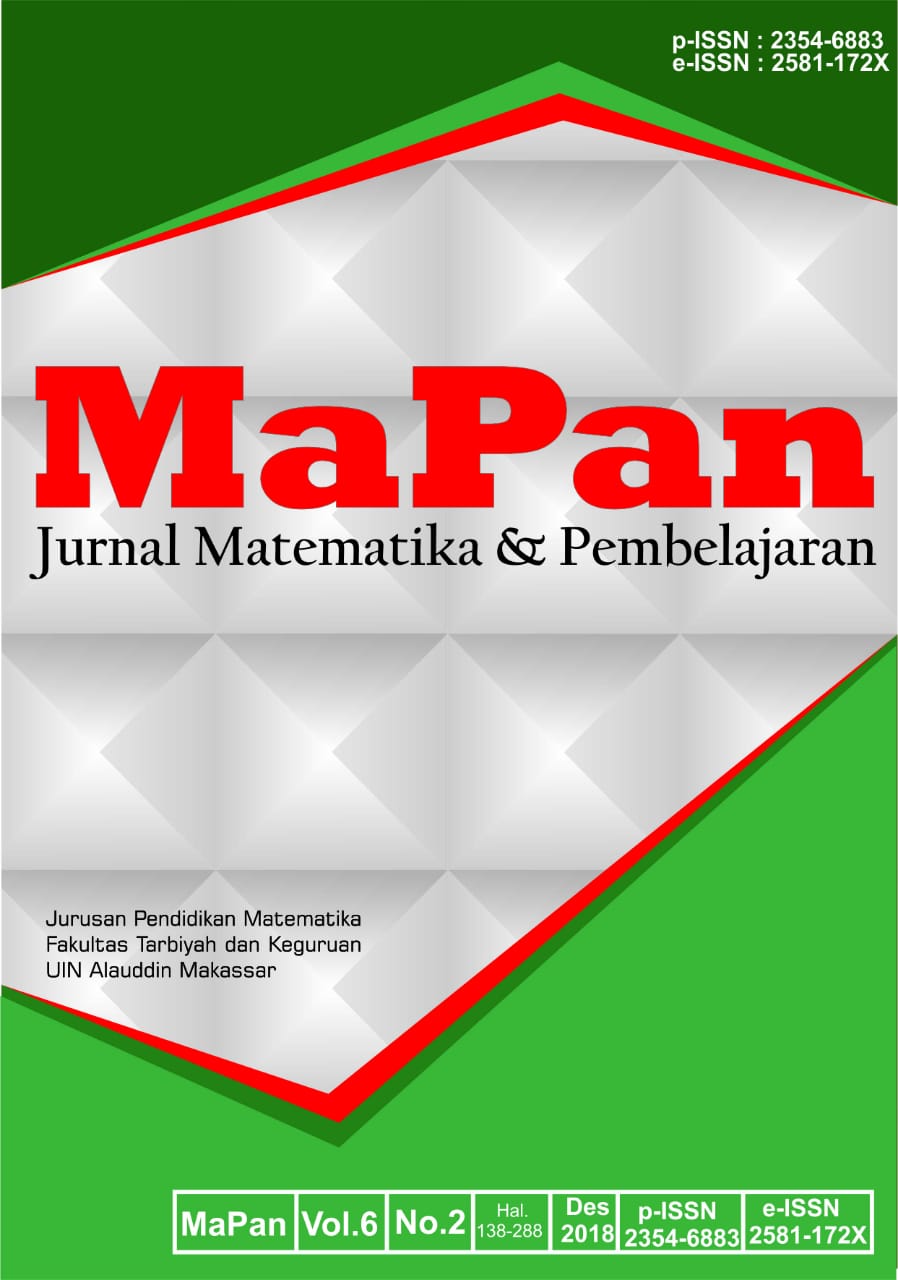KEMAMPUAN KONEKSI MATEMATIS SISWA SEKOLAH MENENGAH PERTAMA BERDASARKAN GAYA KOGNITIF
Abstract
Abstrak:
Tujuan penelitian ini adalah mendeskripsikan kemampuan koneksi matematis siswa sekolah menengah pertama yang ditinjau dari gaya kognitif Field Dependent (FD), Field Intermediate (FDI), dan Field Independent (FI). Subjek penelitian ini adalah adalah siswa SMP Negri 3 Batu kelas VIII-G berjumlahkan 26 siswa yang dikelompokan berdasarkan gaya kognitif yang dimiliki oleh setiap siswa, setiap kelompok gaya kogitif diambil perwakilan 2 subjek dengan menggunakan metode purposive sampling untuk diukur kemampuan koneksi matematisnya. Berdasarkan hasil penelitian ini kemampuan koneksi matematis yang dimiliki oleh setiap siswa berbeda-beda. Subjek dengan kelompok gaya kognitif Field Independent (FI) memiliki perbedaan kemampuan koneksi matematis, salah satu subjek dapat memenuhi semua indikator dan subjek lainnya hanya memenuhi beberapa kemampuan koneksi matematis. Hal ini menunjukan bahwa subjek yang termasuk dalam kelompok gaya kognitif yang sama belum tentu memiliki kemampuan koneksi yang sama. Subjek dengan kelompok gaya kognitif Field Intermediate (FDI) hanya memenuhi beberapa indikator kemampuan koneksi matematis. Subjek degan gaya kognitif Field Dependent (FD) belum dapat memenuhi semua indikator kemampuan koneksi matematis. Hal ini menunjukan bahawa subjek yang memiliki gaya kognitif yang sama belum tentu memiliki kemampuan koneksi matematis yang sama juga.
Abstract:
The objective of this study is to describe the mathematical connection ability of junior high school students in terms of the cognitive styles of Field Dependent (FD), Field Intermediate (FDI), and Field Independent (FI). The subjects of this study were the students of State Junior High School 3 Batu of class VIII-G consisting of 26 students who were grouped based on the cognitive style possessed by every student. The study used purposive sampling technique for selecting the sample by taking 2 representative students from every cognitive style group to measure their mathematical connection abilities. The findings show that the students’ mathematical connection abilities are different each other. The students from Field Independent (FI) cognitive style group have different mathematical connection abilities, one student can fulfill all indicators and the other one only fulfills some mathematical connection abilities. It can be inferred that the students who have the same cognitive style group do not necessarily have the same connection ability. The students with Field Intermediate (FDI) cognitive style group only fulfill several indicators of mathematical connection ability. The students with Field Dependent (FD) cognitive style cannot fulfill all indicators of mathematical connection ability. It indicates that the students who have the same cognitive style do not necessarily have the same mathematical connection abilities as well.
Downloads
References
Ariawan, R., & Nufus, H. (2017). Profil kemampuan koneksi matematis mahasiswa dalam menyelesaikan masalah pada mata kuliah Kalkulus 1 Ditinjau Berdasarkan Gaya Kognitif. Suska Journal of Mathematics Education, 3(2), 102–110. Retrieved from https://www.researchgate.net/publication/323872135_Profil_Kemampuan_Koneksi_Matematis_Mahasiswa_dalam_Menyelesaikan_Masalah_pada_Mata_Kuliah_Kalkulus_1_ditinjau_berdasarkan_Gaya_Kognitif
Fajriyah, N., & Suseno, A. A. (2014). Kemampuan siswa sekolah menengah pertama dalam menyelesaikan masalah matematika berdasarkan gaya kognitif. Jurnal Pendidikan Matematika, 2(1), 12–21. Retrieved from https://ppjp.ulm.ac.id/journal/index.php/edumat/article/view/584/498
Guisande, M. A., Paramo, M. F., Tinajero, C., & Almeida, L. S. (2007). Field dependence-independence (FDI) cognitive style: An analysis of attentional functioning. Psikotema, 19(4), 572–577. Retrieved from https://www.redalyc.org/pdf/727/72719405.pdf
Kusmanto, H., & Marliyana, I. (2014). Pengaruh pemahaman matematika terhadap kemampuan koneksi matematis siswa kelas VII semester genap SMP Negeri 2 Kasokandel Kabupaten Majalengka. Eduma: Mathematics Education Learning and Teaching, 3(2), 61–75. Retrieved from http://www.syekhnurjati.ac.id/jurnal/index.php/eduma/article/view/56
National Council of Teachers Mathematics. (2000). Principle and standart for school mathematics. Reston, VA: NCTM.
Ngilawajan, D. A. (2013). Proses berpikir siswa dalam memecahkan masalah matematika materi turunan ditinjau dari gaya kognitif field independent dan field dependent. Pedagogia, 2(1), 71–83. Retrieved from http://ojs.umsida.ac.id/index.php/pedagogia/article/view/48/54
Romli, M. (2016). Profil koneksi matematis siswa perempuan sma dengan kemampuan matematika tinggi dalam menyelesaikan masalah matematika. Jurnal Ilmiah Pendidikan Matematika, 1(2), 145–157. Retrieved from https://media.neliti.com/media/publications/90941-ID-profil-koneksi-matematis-siswa-perempuan.pdf
Sari, A. S. (2017). Kemampuan koneksi matematika siswa pada materi teorema pythagoras ditinjau dari gaya kognitif. Universitas Muhammadiyah Surakarta. Retrieved from http://eprints.ums.ac.id/51242/1/NASKAH PUBLIKASI.pdf
Sari, O. S., Yusmin, E., & Nursangaji, A. (2018). Kemampuan koneksi matematis siswa ditinjau dari gaya kognitif pada materi persegi panjang di SMP. JIPP, 7(6). Retrieved from http://jurnal.untan.ac.id/index.php/jpdpb/article/view/26060/75676577030
Sugiarti, S., & Basuki. (2014). Pengaruh model pembelajaran berbasis masalah terhadap kemampuan koneksi matematika siswa dalam pembelajaran matematika. Jurnal Pendidikan Matematika, 3(3), 151–158. Retrieved from https://media.neliti.com/media/publications/226603-pengaruh-model-pembelajaran-berbasis-mas-c45daf56.pdf
Sugiman. (2008). Koneksi matematik dalam pembelajaran matematika di Sekolah Menengah Pertama. Pythagoras, 4(1), 56–66. Retrieved from https://journal.uny.ac.id/index.php/pythagoras/article/view/687/550
Ulya, H. (2015). Hubungan gaya kognitif dengan kemampuan pemecahan masalah matematika siswa. Jurnal Konseling Gusjijang, 1(2). Retrieved from http://jurnal.umk.ac.id/index.php/gusjigang/article/view/410/442
Ulya, H., Kartono, & Retnoningsih, A. (2014). Analysis of mathematics problem solving ability of Junior High School students viewed from students‘ cognitive style. International Journal of Education and Research, 2(10), 577–582. Retrieved from http://icmseunnes.com/2015/wp-content/uploads/2015/10/1.pdf
Usodo, B. (2011). Profil intuisi mahasiswa dalam memecahkan masalah matematika ditinjau dari gaya kognitif field dependent dan field independent (pp. 96–172). Retrieved from https://s3.amazonaws.com/academia.edu.documents/31976186/JURNAL_KUALITATIF.PDF?AWSAccessKeyId=AKIAIWOWYYGZ2Y53UL3A&Expires=1544616732&Signature=JiDTfdJLn%2FP2pXmobCk%2BEsNZkE4%3D&response-content-disposition=inline%3B filename%3DJURNAL_KUALITATIF.pdf
Witkin, H. A., Moore, C. A., Goodenough, D. R., & Cox, P. W. (1977). Field-dependent and field-independent cognitive styles and their educational implication. Review of Educational Research Winter, 47(1), 1–64. Retrieved from https://onlinelibrary.wiley.com/doi/abs/10.1002/j.2333-8504.1975.tb01065.x
Yanirawati, S., Nilawasti, & Mirna. (2012). Pembelajaran dengan pendekatan konstektual disertai tugas peta pikiran untuk meningkatkan kemampuan koneksi matematika siswa. Jurnal Pendidikan Matematika, 1(1), 1–7. Retrieved from http://ejournal.unp.ac.id/students/index.php/pmat/article/view/1147/839
Yousefi, M. (2011). Cognitive style and EFL learner’s listening comprehension ability. Indonesian Journal of Applied Linguistics, 1(1), 73–83. Retrieved from http://ejournal.upi.edu/index.php/IJAL/article/view/100/64
Copyright (c) 2018 Maulidyah Firdausi

This work is licensed under a Creative Commons Attribution 4.0 International License.


